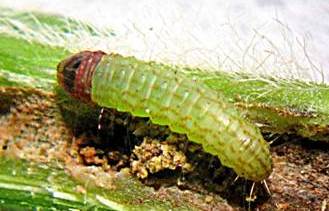Two new insecticides have recently been registered to control Bemisia tabaci B-biotype in cotton. Product Insecticide group Active ingredient Pest Exirel® anthranilic diamide (Group 28) cyantraniliprole SLW, Helicoverpa, cotton aphid (suppression only) Starkle® neonicotinoid (Group 4A) dinotefuran SLW & green mirid Exirel® was registered for cotton use in the 2013/14 season, and Starkle® has been registered for the current cotton… Read more »
Over the past two winters, agronomists and growers have been asking whether the green mirids that they are finding in faba beans are doing any damage. Until now, the short answer to that was that we simply didn’t know. In 2014 Department of Agriculture and Fisheries (DAF) Entomology conducted a preliminary trial to determine if green mirids could cause the… Read more »
Emerging and vegetative summer crops in close proximity to unharvested winter crop are at risk of thrip damage, but the damage is largely cosmetic and rarely warrants treating. Thrips breed up in winter cereals, and particularly after rain, will move out of the winter crops in huge numbers. Most of you will be familiar with the joys of thrips biting… Read more »
As the early and moisture stressed crops finish up, and those that were under a storm kick on, it is challenging to try and estimate whether small helicoverpa larvae in the crop should be controlled, or whether the crop will finish up before they get to a damaging size. There are a few things to keep in mind when making… Read more »
Helicoverpa moth activity to 19 October, 2015. Over the past 1-2 weeks we have seen increasing H. armigera catches in the pheromone traps across Queensland (Qld) and northern New South Wales (NSW). The series of graphs of H. armigera and H. punctigera trap catches from August to 19 October are below. Included with these graphs are the current predictions for… Read more »
Where there is a history of soil insect damage resulting in poor crop establishment a pre-sowing inspection of the affected fields is warranted to determine the likely risk to the upcoming summer crop. Grain baits are an effective way of monitoring for soil-dwelling insect pests of summer crops, and is preferable to sampling with a shovel, which is both time… Read more »
Helicoverpa pheromone trap catches to 18 September 2015 This information is updated weekly on Fridays and/or the following Monday. Where the data for the current week is not yet available, click on the location marker to see data from previous weeks. The Northern region pheromone trap network is part of a national network of traps being run in 2015, funded… Read more »
Helicoverpa armigera active now. This spring a number of agronomists have just started monitoring pheromone traps across the northern region, and the results from the past two weeks illustrate how useful pheromone traps can be. Over the past 1-2 weeks, the traps are catching relatively high numbers of Helicoverpa armigera, and low catches of H. punctigera. In September it is generally assumed that… Read more »
Background A new leaf-mining fly, the vegetable leafminer (Liriomyza sativae), has recently been found at Seisia on the western side of the top of Cape York, Queensland. Originally from the Americas, since the 1980s this pest has spread westwards across the Pacific into Asia and has been island hopping across Torres Strait since 2008. Any suspected sightings of the pest should be… Read more »
There is an understandable level of concern about how best to manage etiella (Etiella behrii) in summer mungbean crops following the unexpectedly high etiella infestations (and corresponding seed damage and contamination) in spring mungbean crops on the Downs and in Central Queensland and North Western New South Wales. Responding to the etiella threat without reacting prematurely and creating more pest… Read more »

